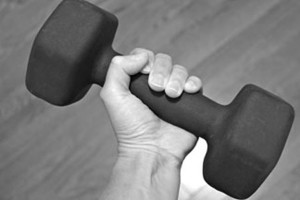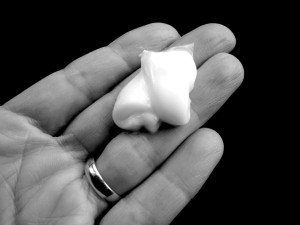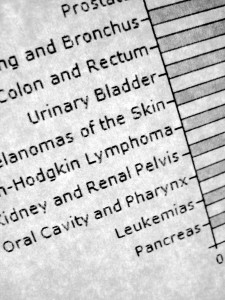True.
Most of us have experienced muscle cramps at some point in our lives, whether being awakened from a deep sleep with hamstring spasms or being unable to finish a tennis match because of cramping calf muscles. Muscle cramps are fairly common, and the severity can range from mild to debilitating.
I experienced this firsthand during a football game when I was a junior in high school. We were playing our cross-town rivals, and it was a hot and humid September night.
I wasn’t the greatest of football players, but I had just sprinted the width of the field to make a touchdown-saving tackle late in the fourth quarter. As I got back on my feet, an immediate pain in my entire abdominal region first bent me over, and seconds later sent me tumbling to the ground, where I lay writhing in pain.
This severe abdominal muscle cramping was one of the most painful things I have ever experienced. After a few minutes of applying ice and stretching those muscles, the cramps subsided and I returned to the game, which we won by one point. e night was memorable because the win earned our team the conference championship—and because of the profound pain I had experienced.
Experts don’t fully understand the cause of muscle cramps. One possible explanation is dehydration and loss of electrolytes such as sodium, often due to sweating. Sodium and other electrolytes are important for muscle function, which could be why muscle cramps often occur near the end of practices or games.
Another possible explanation for muscle cramps is exhaustion or fatigue, again because cramping frequently occurs near the end of sports practices, games, or a long run or bike ride—times of significant exertion or overexertion. ere are small nerves in our bodies that keep muscles from over-firing or over-contracting, and these nerves might malfunction when muscles are fatigued.
The idea of giving athletes pickle juice to prevent cramping gained popularity in 2000 when an athletic trainer for the Philadelphia Eagles served it to his athletes on their way to a 41–14 victory over the Dallas Cowboys in the Texas heat. e trainers reported no player cramping during the game.
Little research has been done on this topic, but one study conducted by Miller and colleagues (2010) showed that pickle juice significantly shortened the duration of electrically induced muscle cramps in dehydrated humans, whereas water had no effect on cramp duration.
It is unlikely that the pickle juice affected hydration or electrolyte levels. e authors speculated that the acetic acid (vinegar) in the juice might have triggered an “inhibitory oropharyngeal reflex shortly after ingestion, which reduces alpha motor neuron activity to cramping muscles.”
In other words, the acetic acid in pickle juice could break the spasm cycle by coming in contact with small nerves in the throat. However, I could find no evidence that consuming pickle juice prior to activity helps reduce muscle cramping.
Miller, K., Mack, G., Knight, K., Hopkins, J., Draper, D., Fields, P., and Hunter, I. Reflex inhibition of electrically induced muscle cramps in hypohydrated humans. Medicine & Science in Sports & Exercise (2010), Vol 42, pp. 953-961.


 False.
False.

 ately refer to dogs as man’s best friend. I’ve grown up with dogs and have always had dogs in my life, so I would wholeheartedly agree with that statement. Dogs provide us with companionship, help seeing-impaired individuals safely navigate streets and sidewalks, and help farmers and ranchers herd sheep and cattle; dogs are also used to locate missing persons and detect things like drugs and bombs (a dog’s sense of smell is estimated to be 10,000 to 100,000 times more sensitive than a human’s). Recently, I had a chance to spend some time with a gentleman (Mike) from England at an outdoor archery range. Mike happened to have epilepsy and always traveled with his dog. I learned that day that Mike’s dog could warn Mike before he was going to have a seizure. Usually the warning (barking) came two to five hours before a seizure occurred, and Mike said his dog was right one hundred percent of the time. I was truly amazed! It now appears that dogs may also start being used to help detect cancer. A study by McCulloch and colleagues (2006) published in the journal Integrative Cancer Therapies examined whether dogs could be trained to detect cancer simply by sniffing someone’s breath. Due to increased oxidative stress, cancer cells emit slightly different waste products than normal cells. The results of the study suggest that dogs can be trained to smell cancer with high degrees of sensitivity and specificity. The authors concluded that “training was efficient and cancer identification was accurate; in a matter of weeks, ordinary household dogs with only basic behavioral ‘puppy training’ were trained to accurately distinguish breath samples of lung and breast cancer patients from those of controls.” The dogs used for the study were Portuguese water dogs and Labrador retrievers, but the ability to be trained to detect cancer is probably not breed specific.
ately refer to dogs as man’s best friend. I’ve grown up with dogs and have always had dogs in my life, so I would wholeheartedly agree with that statement. Dogs provide us with companionship, help seeing-impaired individuals safely navigate streets and sidewalks, and help farmers and ranchers herd sheep and cattle; dogs are also used to locate missing persons and detect things like drugs and bombs (a dog’s sense of smell is estimated to be 10,000 to 100,000 times more sensitive than a human’s). Recently, I had a chance to spend some time with a gentleman (Mike) from England at an outdoor archery range. Mike happened to have epilepsy and always traveled with his dog. I learned that day that Mike’s dog could warn Mike before he was going to have a seizure. Usually the warning (barking) came two to five hours before a seizure occurred, and Mike said his dog was right one hundred percent of the time. I was truly amazed! It now appears that dogs may also start being used to help detect cancer. A study by McCulloch and colleagues (2006) published in the journal Integrative Cancer Therapies examined whether dogs could be trained to detect cancer simply by sniffing someone’s breath. Due to increased oxidative stress, cancer cells emit slightly different waste products than normal cells. The results of the study suggest that dogs can be trained to smell cancer with high degrees of sensitivity and specificity. The authors concluded that “training was efficient and cancer identification was accurate; in a matter of weeks, ordinary household dogs with only basic behavioral ‘puppy training’ were trained to accurately distinguish breath samples of lung and breast cancer patients from those of controls.” The dogs used for the study were Portuguese water dogs and Labrador retrievers, but the ability to be trained to detect cancer is probably not breed specific.  If I were to base my response to this myth on what occurs in television shows and movies, the answer would be a resounding “yes!” TV shows and movies frequently have werewolves, zombies, and many other undesirables coming out during a full moon to engage in their sinister activities. These media outlets also exaggerate the amount of crime and abnormal human behavior that occurs during a full moon. This idea that the moon triggers a wide variety of deviant behavior in humans has been with us for many years. Consider that lunacy, which means insanity, is derived from the Latin word “luna” for moon. The full moon is frequently associated with or blamed for things like murder and other crimes, alcoholism, epilepsy, arson, natural disasters, suicide, and mental illness. It is also common for people to think that the moon influences things like the weather, fertility, and birthrates. We frequently read about police officers, paramedics, nurses, and physicians believing that crime rates increase and emergency room visits skyrocket during periods of a full moon. However, this belief is not supported by scientific studies. A few of the many studies that have been conducted on this topic have shown a relationship or association between the full moon and bad behavior, but the overwhelming evidence suggests there is no correlation between the two. Rotton and Kelly (1985) reviewed thirty-seven studies on this topic in an article published in the journal Psychological Bulletin and stated, “Although this meta-analysis uncovered a few statistically significant relations between phases of the moon and behavior, it cannot be concluded that people behave any more (or less) strangely during one phase of the moon than another.” Again, most of the studies conducted and published do not support the idea that the full moon influences human behavior in any way whatsoever.
If I were to base my response to this myth on what occurs in television shows and movies, the answer would be a resounding “yes!” TV shows and movies frequently have werewolves, zombies, and many other undesirables coming out during a full moon to engage in their sinister activities. These media outlets also exaggerate the amount of crime and abnormal human behavior that occurs during a full moon. This idea that the moon triggers a wide variety of deviant behavior in humans has been with us for many years. Consider that lunacy, which means insanity, is derived from the Latin word “luna” for moon. The full moon is frequently associated with or blamed for things like murder and other crimes, alcoholism, epilepsy, arson, natural disasters, suicide, and mental illness. It is also common for people to think that the moon influences things like the weather, fertility, and birthrates. We frequently read about police officers, paramedics, nurses, and physicians believing that crime rates increase and emergency room visits skyrocket during periods of a full moon. However, this belief is not supported by scientific studies. A few of the many studies that have been conducted on this topic have shown a relationship or association between the full moon and bad behavior, but the overwhelming evidence suggests there is no correlation between the two. Rotton and Kelly (1985) reviewed thirty-seven studies on this topic in an article published in the journal Psychological Bulletin and stated, “Although this meta-analysis uncovered a few statistically significant relations between phases of the moon and behavior, it cannot be concluded that people behave any more (or less) strangely during one phase of the moon than another.” Again, most of the studies conducted and published do not support the idea that the full moon influences human behavior in any way whatsoever.

